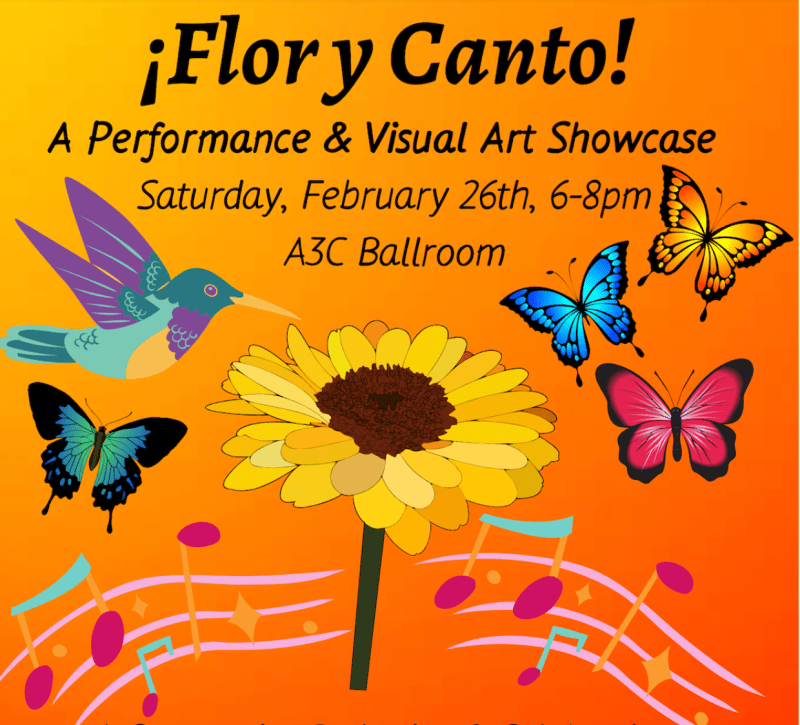With the return to campus, community traditions like Flor y Canto (flower and song) — an annual performance and visual art showcase hosted by the Ethnic Theme Associates (ETA) of Casa Zapata — have been revived. Flor y Canto will take place during family weekend on Saturday, Feb. 26 from 6 p.m. to 8 p.m. in the ballroom of the Asian American Activities Center.
Students and community members can look forward to spoken word, dancing and singing performances, including music from Mariachi Cardenal. The visual art showcase will display the community’s artistry and talent through a mix of photography, drawings and collages.
Casa Zapata’s annual tradition was first known as “Zoot Suit Week” and was once a week-long series of events that celebrated the Zoot Suit era of the 1940s. ETA Kevin Calderon ’22 wrote in a comment to The Daily that Zoot Suit Week, a Stanford tradition that goes back to the ’80s, was changed to Flor y Canto in the early 2010s to “include more narratives outside of Mexican identity.”
Casa Zapata Resident Fellow Elvira Prieto, Ed.M. ’96, who is also the associate dean of students and director of El Centro Chicano y Latino, said that Flor y Canto was first led by artist José Antonio Burciaga. José and his wife Ceclia Burciaga served as resident fellows for Casa Zapata in the 1980s. Cecilia fulfilled various positions at Stanford, including associate dean of graduate studies, assistant provost for faculty affairs and assistant to the president and provost for Chicano affairs. José also created some of the murals in the house, most notably, the “Last Supper of Chicano Heroes” in Stern Dining.
The name “Flor y Canto” originates from a Nahuatl expression referring to poetry that was integrated with music and dance. Prieto emphasized that the phrase’s Indigenous origins are “an important piece for folks to know.”
“The ‘flor’ is in reference to poetry and written word, the ‘canto’ is any kind of musical expression, whether it be song, music or performance,” Prieto explained. “It was a coming together of artists and creative folks to share their creativity with each other in a way that promoted the owning and the honoring of space — culture.”
After two years of uncertainty and loss amid the pandemic, Prieto views the event with hope and wants students and the community to share space for wellness and healing.
“I want for students and for community members to feel uplifted, and to fill our hearts and our spirits with light and joy which we really need right now,” Prieto said.
Casa Zapata Resident Assistant Issac Garcia ’22 experienced Flor y Canto before the pandemic and wonders how it will play out under the current atmosphere of COVID-19 uncertainty.
“Everybody’s been out for so long and might be disconnected from what Zapata is or what it used to be,” Garcia said. “It might be a little weird considering everybody will have masks and there will be new grounds to navigate.”
Garcia reminisced about student performances from the 2019 Flor y Canto. They remember original music, a cover of a Selena song and a performance from Ballet Folklorico at the event. At the visual art showcase, they recall portraits, plein air paintings, collages and photography.
Despite the new circumstances, Garcia looks forward to Flor y Canto celebrating members of the community and giving students a break as the final stretch of the quarter approaches: “It’s easy to get lost in the flow of school, psets, essays and midterms. So to have this one event this weekend. For me, it’s like a shining star.”
Casa Zapata frosh Crystal Jauregui ’25 is excited for her family to experience the community she’s a part of and to see their culture represented on campus.
“They’re gonna see that I’m at a space that kind of feels like home,” Jauregui said. “It’s gonna be really nice to see that my family can relate to something here because it’s like, ‘we didn’t go to school; we didn’t go to college.’ But, for them to see that part of their culture is here, and I’m here representing our culture — it’s going to be really exciting.”
Students in other dorms outside of Casa Zapata are able to join the community by becoming “fourth-floor” residents. Casa Zapata has three floors and the metaphorical “fourth floor” is intended to make students outside of the dorm feel like they are part of the Zapata community. Jauregui hopes that Flor y Canto lets “fourth-floor” students know there is a space for them on campus.
“We have a community here, and it is a safe space. There’s so much love and care in this community that they can experience, especially if it’s people who don’t live in Zapata,” Jauregui said.
In an email publicizing the event, Calderon wrote that Flor y Canto “is a tradition that celebrates and centers the arts in the house and the broader Latinx community as a form of cultural celebration, and a commitment to the political heart of our home: Comunidad!”
Jauregui hopes that attendees will leave the event with gratitude for cultural representation within the community at Casa Zapata and Stanford.
“They can see there’s a community at Stanford that represents where we come from and all the talents that we were given,” Jauregui said.
